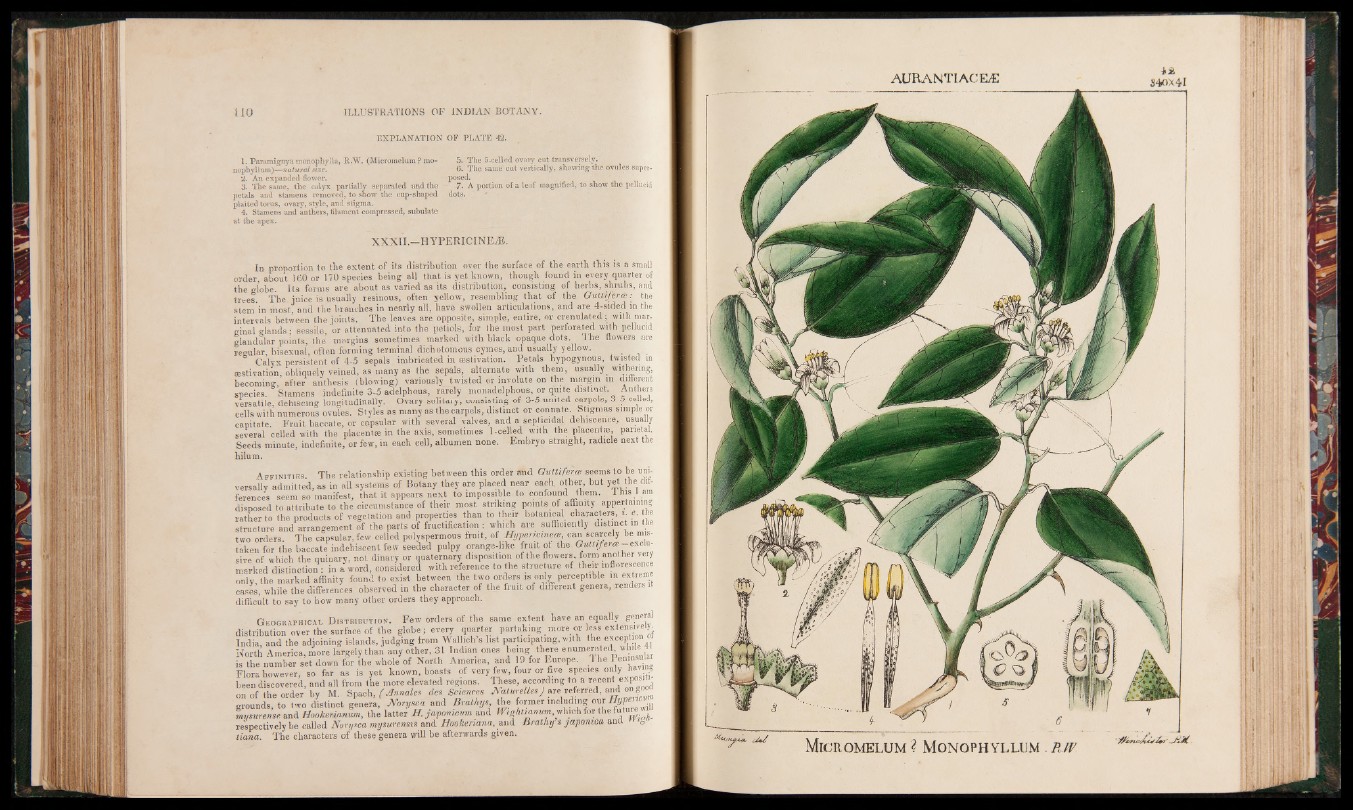
110 ILLUSTRATIONS OF INDIAN BOTANY.
EXPLANATION OF PLATE 42.
1. Paramignya monophylla, R.W. (Micromelum P mo-
nophyllum)—natural sine.
2. An expanded flower.
3. The same, the calyx partially separated and the
petals and stamens removed, to show the cup-shaped
plaited torus, ovary, style, and stigma.
4. Stamens and anthers, filament compressed, subulate
at the apex.
5. The 5-celled ovary cut transversely.
6. ' The same cut vertically, showing the ovules superposed.
7. A portion of a leaf magnified, to show the pellucid
dots. |
XXXII.—HYPERICINEÆ.
In proportion to the extent of its distribution over the surface of the earth this is a small
order, about 160 or 170 species being all that is ye.t known, though found in every quarter of
the globe. Its forms are about as varied as its distribution, consisting of herbs, shrubs, and
trees The juice is usually resinous, often yellow, resembling that of the Gutliferai •• the
stem in most, and the branches in nearly all, have swollen articulations, and are 4-sided in the
intervals between the joints. The leaves are opposite, simple, entire, or crenulated; with marginal
glands; sessile, or attenuated into the petiols, for the most part perforated.with pellucid
glandular points, the’ margins sometimes marked with black opaque dots. '1 he flowers are
regular b is e x u a l, often forming terminal dichotomous cymes, and usually yellow.
Calyx persistent of 4-5 sepals imbricated in aestivation. Petals hypogynous, twisted in
aestivation, obliquely veined, as many as the sepals, alternate with them, usually withering
becoming, after anthesis (blowing) variously twisted ot involute on the margin m different
species. Stamens indefinite 3-5 adelphous, rarely monadelphous, or quite distinct. Anthers
versatile, dehiscing longitudinally. Ovary solitary, consisting-of 3-5 united carpels, 3-5 celled,
cells with numerous ovules. Styles as many as the carpels, distinct or connate. Stigmas simple or
capitate. Fruit baccate, or capsular with several valves, and a septicidal dehiscence, usually
several celled with the placentm in the axis, sometimes 1-celled with the placent®, parietal.
Seeds minute, indefinite, or few, in each cell, albumen none. Embryo straight, radicle next the
hilum.
Affinities The relationship existing between this order aiid Gultifera seems to be universally
admitted, as in all systems of Botany they are placed near each, other, but ye‘ ‘he differences
seem so manifest, that it appears next to impossible to confound them. 1 his 1 am
disposed to attribute to the circumstance of their most striking points of affinity appertaining
rather to the products of vegetation and properties than to their botanical characters,«. e. the
structure and arrangement of the parts of fructification : which are sufficiently distinct in the
two orders. The capsular, few celled polyspermous fruit, of Hypencineai can scarcely be mistaken
for the baccate indehiscent few seeded pulpy orange-like fruit of the Guttiferai exclusive
of which the quinary, not dinary or quaternary disposition of the flowers, form another very
marked distinction : in a word, considered with reference to the structure of their^florescence
only, the marked affinity found to exist between the two orders is only perceptible g ^ B B S I
cases, while the differences observed in the character of the fruit of different genera, .renders it
difficult to say to how many other orders they approach.
G eographical D istribution. Few orders of the same extent have an equally general
distribution over the surface of the globe; every quarter partaking more or less extensively
India, and the adjoining islands, judging from Wallich’s list participating, with the except on ot
North America, more largely than any other, 31 Indian ones being there enumerated while 4
is the number set down for the whole of North America, and 19 for Europe. 1 he P a n o la
Flora however, so far as is yet known, boasts of very few, four or five species j j l g g S i
been discovered, and all from the more elevated regions. These, according to a jecentocxposu
on of the order by M. Spach, f i n a l e s des Sciences JValu.rellesJ are. referred, ^ on| 0»“
grounds, to two distinct genera, Norysca and Brathys, the former including our^W;_
mysurense and Hooker,ianum, the latter H. japomcum and Wightianum, which for the fatav
respectively be called Norysca mysurensis and Hookeriana, and Brainy s japonica ana 6
liana. The characters of these genera will he afterwards given.
AURANTIACEÆ
Micromelum ? Monophyllum . tu v
$40X41